Jade Gregg
NCES
I am no garden guru but I am passionate about food security and serious about laziness…er…efficient systems.
Permaculture design systems make food production more abundant and decrease the labour required. So, maybe it is my sloth-like tendencies that inspired me to geek out on permaculture. Simply put, permaculture is a set of ecological design principles. But what does that mean? Farming through the use of permaculture principles diverges from what is referred to as “conventional” farming. Instead of pesticide-sprayed mono-crops, with nutrient-deficient soil requiring outside inputs, permaculture shows us an easier way.
When I was younger, I would visit my uncle’s poultry farm in Saskatchewan, which featured a giant warehouse. I have worked or visited at more than two dozen farms since, and all are more like natural environments.
In the words of Joel Salatin, those farms were “aesthetically and aromatically, sensually romantic”—exactly what good food production should be. Instead of segregating the birds from the land, chickens were often loose or contained in mobile chicken coops, consistently providing the animals with fresh, new grass and bugs to eat. Mobile chicken coops are tools for rotational grazing and it is biological mimicry; wild animals move, they are not stationary and, in confinement, the farmer can facilitate that movement.
The results are impressive.
A regenerating forest does not till itself; by shedding its leaves, it slowly builds on its soil base. Our own local Track Street Growers soil build too.
Soil building discourages tilling the soil because doing so disturbs the microbiome. Instead, Track Street build up and allow the microbiome to digest and re-integrate the nutrients in-situ. This retains the original nutrient base and builds on it through in place decomposition.
From Natural Building to rainwater harvesting and Hügelkultur to Keyline Design, there is much to explore about permaculture.
So far, I have had an opportunity to play with companion planting, layering and the use of zones.
Certain plants like to grow together. You may have heard of the three sisters which are the planting of corn, climbing beans and crawling squash together, not in separate rows. Sturdy, tall corn shoots provide a pole for the beans to climb while the beans affix nitrogen to the soil.
The squash crawls along the ground; its big leaves shade the soil, helping it to retain water. Companion planting can also deliver higher yields and deter pests.
It also reduced my labour. I did not have to fertilize the soil for the nitrogen-hungry plants and I did not have to irrigate as often.
I use zones to spatially plan the edible food forest around my home. It is based on how frequently I must tend to the needs of the various organisms.
Starting with zone one, closest to my home, I plant that which I use most frequently: this is where my herbs, salad greens and compost are. Moving outward, we find my greenhouse in zone two, where semi-intensely cultivated plants such as tomatoes and basil keep warm. Zone three is for occasionally visited crops like my plum and hazelnut trees. Even further from the back door, zone four is for that which requires minimal care: this might be a wood cutting lot for fuel and timber or for pastured animals. Lastly, furthest away from the home, zone five is ideally a wilderness zone so that its accumulation of rich bacteria can be shared with the zones above.
By refocusing on the natural interdependence of water, soil, nutrients, flora and fauna we find solutions that were in front of us the whole time. Permaculture also demands that we include ourselves in the systems, reintegrating the human animal back into the equation.
Hopefully, my lazy tips inspire you to explore more cohesive food-growing systems and that your experiments offer you more time to spend on life’s other important things.
Jade Gregg is a board member of the North Columbia Environmental Society.
